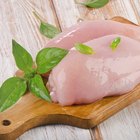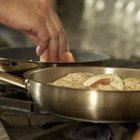
A meal with stuffed chicken as the star of the menu will often appeal to kids. Keep the stuffing simple, skipping the exotic ingredients, and most kids will enjoy the traditional breading along with tender poultry. Simple sides like a tossed salad with creamy dressing and a cooked green vegetable complete the meal. Because poultry and the eggs in stuffing can become a host for harmful bacteria, it is not safe to stuff a chicken the night before cooking. Instead, there are time-saving steps you can take to handle these foods carefully in the kitchen.
Prepare Stuffing
Prepare and mix the stuffing ingredients immediately before you plan to cook the chicken for best results. If you wish to complete some preparation work ahead of time, mix all of the dry ingredients together, and mix the wet ingredients together separately, but do not combine the dry and the wet ingredients until immediately before you stuff the chicken and cook it.
The Night Before
To safely perform some of the preparation work ahead of time, cut up the bread and mix it with the onions, celery, and any other vegetables you're using, plus spices. Do not put eggs or other wet ingredients in, but stir them together in a separate bowl. Prepare the chicken by removing the giblets and neck, rinsing out the cavities, and patting the chicken dry with paper towels. Refrigerate the prepared stuffing ingredients and the chicken overnight. When you're ready to start cooking, combine the stuffing ingredients, spoon them loosely into the chicken cavity, and roast the chicken immediately after stuffing.
Stuffing Storage
If you mix a complete stuffing using both the dry and wet ingredients, but then aren't ready to stuff and cook the chicken yet, the only safe storage method is to freeze the stuffing, according to the Food Safety Inspection Service of the U.S. Department of Agriculture. Spread the prepared stuffing in a shallow storage container, cover it, and freeze it immediately. The USDA recommends cooking the stuffing without thawing it. Remove the frozen stuffing from the freezer, break it apart into small chunks, and place it into the chicken cavity. Put it into a preheated oven right away.
Roasting the Stuffed Chicken
Whichever method you use, roast the stuffed chicken according to your recipe. When both the stuffing inside the chicken and the chicken meat at the thickest part reach a temperature of 165 F, remove the chicken from the oven. Allow it to stand for about 20 minutes and then transfer the stuffing to a serving bowl. Carve the chicken and serve it immediately.
Related Articles

How to Cook Mojo Chicken

How Do I Make Baked Boneless Chicken ...

How to Defrost a Chicken in a ...

How to Slow Cook Chicken With Tomatoes ...

Can I Cook a Whole Chicken Without ...

Can I Cook Chicken That's Been Thawed ...

How Do I Cook Chicken Quesadillas Like ...

How to Cook Boneless Turkey Breast

How to Check the Internal Temp of a ...

How to Marinate Roast Chicken

How to Pickle Brine Sausage

How to Clean a Musty Smell from the ...

How to Make Crock-pot Chicken

The Proper Way to Inject Marinade Into ...
Can I Prepare a Chicken Dish Hours ...

Can I Stop Cooking a Chicken Halfway & ...

How Do I Stuff a Chicken Breast So the ...

How to Dress a Chicken for Cooking

Mom’s Classic Make-Ahead Bread Stuffing

How to Roast a Split Turkey
References
Writer Bio
Kathryn Hatter is a veteran home-school educator, as well as an accomplished gardener, quilter, crocheter, cook, decorator and digital graphics creator. As a regular contributor to Natural News, many of Hatter's Internet publications focus on natural health and parenting. Hatter has also had publication on home improvement websites such as Redbeacon.
Photo Credits
Jupiterimages/Comstock/Getty Images